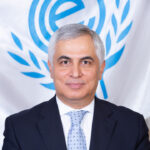UNITED NATIONS, Sep 15 (APP): The world has never been in a better position to end the coronavirus pandemic, the head of the World Health Organization (WHO) has said, his most optimistic outlook yet on the years-long health crisis which has killed over six million people.
At the same time, WHO Director-General Tedros Adhanom Ghebreyesus cautioned that “we are not there yet.”
“We have never been in a better position to end the pandemic,” Tedros said, noting that the number of deaths from COVID-19 last week was the lowest it had been since March of 2020.
“If we don’t take this opportunity now, we run the risk of more variants, more deaths, more disruption and more uncertainty, so let’s seize this opportunity,” WHO chief added.
Tedros urged governments to “take a hard look” at their policies and “strengthen them for COVID-19 and future pathogens with pandemic potential”.
“We urge all countries to invest in vaccinating 100% of the most at-risk groups, including health workers and older people,” he said and asked the countries to “keep testing and sequencing” for COVID-19 virus.
As the number of weekly reported deaths from COVID-19 plunged to its lowest since March 2020, the head of the World Health Organization (WHO) said on Wednesday that the end of the pandemic was now in sight.
He also warned that “if the world does not take the opportunity now, there is still a risk of more variants, deaths, disruption, and uncertainty.”
“So, let’s seize this opportunity”, he urged, announcing that WHO was releasing six short policy briefs that outline the key actions that all governments must take now to “finish the race”.
The policy briefs are a summary, based on the evidence and experience of the last 32 months, outlining what works best to save lives, protect health systems, and avoid social and economic disruption.
“[They] are an urgent call for governments to take a hard look at their policies and strengthen them for COVID-19 and future pathogens with pandemic potential,” Tedros said.
The documents, which are available online, include recommendations regarding vaccination of most at-risk groups, continued testing and sequencing of the SARS-CoV-2 virus, and integrating effective treatment for COVID-19 into primary healthcare systems.
They also urge authorities to have plans for future surges, including the securing of supplies, equipment, and extra health workers.
The briefs also contain communications advice, including training health workers to identify and address misinformation, as well as creating high-quality informative materials.
Tedros underscored that WHO had been working since New Year’s Eve 2019 to fight against the spread of COVID and would continue to do so until the pandemic was “truly over”.
“We can end this pandemic together, but only if all countries, manufacturers, communities and individuals step up and seize this opportunity,” he said.
Dr Maria Van Kerkhove, WHO’s technical lead on COVID-19, highlighted that the virus was still “ intensely circulating” around the world and that the agency believed that case numbers being reported were an underestimate.
“We expect that there are going to be future waves of infection, potentially at different time points throughout the world caused by different sub-variants of Omicron or even different variants of concern,” she said, reiterating her previous warning that the more the virus circulates, the more opportunities it has to mutate.
However, she said, the future waves did not need to translate into “waves or death” because there were now effective tools such as vaccines and antivirals specifically for COVID-19.





